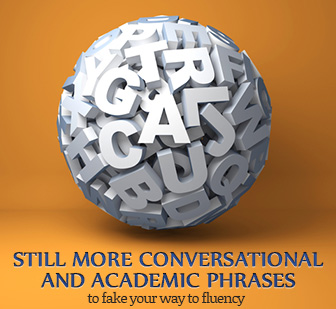I currently am teaching an ESL student who has a great deal of proficiency in conversational English, and he has expressed interest in learning the language for conversation, specifically commonly used phrases for conversation.
Students at the higher levels often express interest in phrases, perhaps because they have control over a certain number of words already, but also because they understand that language really exists in ready-made phrases, and that learning these might be a better investment of their time than trying to memorize a series of grammar rules and then trying to apply them in the correct situations. It is much easier to bring out the correct phrase than search for the correct individual words and grammar rules. Likewise, students in college writing classes find a strong need for academic phrases for writing fluency and “sounding academic.”

Phrases for Academic Writing
Phrases in academic writing function to contrast two propositions or items, to emphasize a point, to negate it, to show cause and effect, and to exemplify—all the tasks of academic writing, which are demonstrated in its language.

-
1
For contrast
All of the following phrases demonstrate some sort of contrast, which is often done in academic writing because of its reflective, analytical nature, where one might contrast the economic situation of two countries, for example, or the education system today and in the past.
*in spite of
*in contrast to
*despite the fact that
*even though
*on the other hand
*Not only…but also (This phrase works in much the same way as “on the other hand” although it may not seem so at first: however, “Not only is she beautiful but also smart,” sets up a contrast of two qualities in applying them to the same person). -
2
Emphasis/negation
Each of the following phrases is used to negate some previous proposition, and do it emphatically.
*By no means…
By no means should our support of this proposal be taken as lack of support for the president, who does not support it.
Used in much the same way are the following phrases:
*on no account…
*under no circumstance… -
3
Cause and effect
*as a result of…
-
4
Exemplification
*an additional example is…

Phrases for Conversation
Phrases in conversation also perform specific functions. These are to emphasize, to negate, to clarify, to deny knowledge of, and to give a directive or suggestion. There is more “clarifying” language in conversation than in writing as it takes face-to-face where the parties can clarify meaning.

-
1
Emphasizing
*I’ll tell you what…
This can be used for emphasizing a point: “I’ll tell you what is so important about this plan…”
It can also be used as a directive: “I’ll tell you what you’re going to do.”
-
2
Negating/Denying knowledge
*I don’t know what…
This can be simply a denial of knowledge: “I don’t know what that means.” It can also be used as a brush-off: that is, as a means of ending a conversation with an individual: “I don’t know what to tell you,” thereby signaling the speaker’s inability or unwillingness to help.
*I haven’t got a clue
-
3
Clarifying
*That’s what I’m saying
*I mean you know
*Do you know what I mean?
*I thought I would (With this phrase, the speaker clarifies some internal intent that might not be clear to others: e.g., “I thought I would get up really early to see the sunrise.”)
-
4
Directives/Suggestions
*You might as well
*Hang on a minute
*Let’s have a look
Methods to Teach Conversational and Academic Phrases
There are a number of methods to teach these phrases that can help students with their fluency in English. Some of them follow:
-
1
Matching
Various matching exercises can be done with these phrases, in which students connect part of the phrase with another: “On the—other hand.” Phrases can also be matched with their meanings or functions. These exercises give students practice with the form and meaning.
-
2
Fill in the Blank
Fill in the blank exercises, in which students fill in a missing word in the phrase, which has usually been placed in the larger context of a paragraph or sentence, gives students intense practice with the form while at the same time seeing how the phrase is actually used in authentic writing.
-
3
Short Assignments
After the practice with matching and fill in the blank exercises, students are now more equipped with understanding of the function and form to practice using these phrases in short writing assignments, such as paragraphs or journals on familiar topics like “A Life Lesson” or “My Favorite Teacher.” The teacher can specify how many phrases students should use, perhaps three to five.
-
4
Role Plays
Students can also do short role plays after giving students a situation: e.g., “You are lost in a mall parking lot. Talk to each other and try to find your car.” Again, students should use a certain amount of phrases, e.g., for directives and denying knowledge: “Hang on a minute…wasn’t it back there?” “I haven’t got a clue…”
-
5
Longer Writing Assignments
Finally, students can do longer writing assignments, such as essays on the causes of war. Again, adding academic phrases will give their writing a more academic sound as well as increase connections between ideas.
Teaching students academic and conversational phrases is time-consuming but pays off enormously in terms of the increase to student vocabulary and fluency.
Do you see the value of teaching academic and conversational phrases? If so, how would you teach them?
P.S. If you enjoyed this article, please help spread it by clicking one of those sharing buttons below. And if you are interested in more, you should follow our Facebook page where we share more about creative, non-boring ways to teach English.







